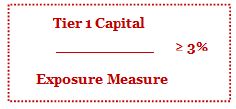Reducing excess "leverage" in the banking sector is a key component of the Basel III capital standards. "Leverage" for these purposes means the ratio between a bank's non-risk-weighted assets and its capital. The ratio is intended to be a hard backstop against the risk-based capital requirements and is also designed to constrain excess leverage, which was common amongst many banks pre-crisis. Banks will be required to hold Tier 1 capital of at least 3% of their non-risk weighted assets but some of the stricter elements of the 2013 proposal have been relaxed.
When the Basel Committee on Banking Supervision (the "Basel Committee") published its consultative document Revised Basel III Leverage Ratio Framework and Disclosure Requirements in June 2013 (the "2013 Consultation"), it was met with substantial opposition, particularly from banks involved in the securities and derivatives markets. Most significantly, the 2013 Consultation did not permit the netting of securities finance transactions and did not allow collateral to reduce derivatives exposures. Some banks feared having to raise billions in extra capital to meet the proposed leverage limit. Having carried out a study of bank data to analyze the potential impact of the proposed reforms, the Basel Committee published an amended full text of the Basel III Leverage Ratio Framework and Disclosure Requirements on 12 January 2014 (the "2014 Revision"), which considerably modified the leverage ratio's exposure measure.
The Leverage Ratio
The leverage ratio is a separate, additional requirement from the binding Basel risk-based capital requirements, so is a supplemental non-risk-based "back-stop." It is defined as the capital measure (the numerator) divided by the exposure measure (the denominator). The capital measure is made up of Basel III Tier 1 capital. The minimum leverage ratio is currently set at 3%.
Thus the method of calculating the leverage ratio is:

The Basel Committee has indicated that it will continue to collect data during the leverage ratio's observation period (i.e. until 1 January 2017) to assess both the appropriateness of a minimum Tier 1 level at 3% over a full credit cycle and for different types of business models, and the impact of using Common Equity Tier 1 or total regulatory capital (Tier 1 +Tier 2) as the capital measure.
The leverage ratio defines exposures (the denominator) as the total of a bank's:
- on-balance sheet assets, including on-balance sheet collateral for derivatives and securities finance transactions not included in items (ii)-(iii) below;
- derivative exposures, comprising underlying derivative contracts and counterparty credit risk ("CCR") exposures;
- securities finance transactions ("SFTs"), including repurchase agreements, reverse repurchase agreements and margin lending transactions; and
- other off-balance sheet exposures, such as commitments (including liquidity facilities), guarantees, direct credit substitutes and standby letters of credit.
The specific treatment of each of these types of exposure is set out in the summary table at the end of this client publication.
The exposure measure under the 2013 Consultation did not generally permit recognition of the exposure-reducing effects of any credit risk mitigation techniques (for example, through guarantees, credit default swaps, collateral or netting of loans and deposits). The 2014 Revision made some concessions in this regard, for example, allowing cash variation margin to reduce exposures when certain conditions are met.
Criticisms of the 2013 Consultation
The main criticism of the 2013 Consultation was that its measures were over-zealous to the extent that they increased the leverage ratio significantly beyond actual economic exposures. The imposition of a considerably larger exposure measure as the denominator would result in the leverage ratio, rather than the Basel III risk-based capital measure, becoming effectively the only minimum capital requirement for a significant number of banks. The 2013 Consultation therefore attracted a fair amount of critique,1 including the following:
Incentives to Hold a Higher Proportion of Riskier Assets. Equating low-risk assets with riskier assets which produce a higher relative return than safer, low-risk assets, but also carry risk of higher exposure could discourage banks from holding assets such as cash and government securities. This may, in turn, negatively impact the liquidity of markets for government debt and monetary policy regimes which are dependent on SFT markets.
Tension with the Liquidity Coverage Ratio ("LCR"). Given that the LCR encourages banks to hold cash and sovereign debt as part of a liquid assets buffer, there is a tension with compliance with the LCR. This criticism would be most relevant to those banks who would find the leverage ratio a greater hurdle to overcome compared to the risk-based capital requirements.
Overstating Actual Economic Exposure ("Double Counting"). Actual economic exposures would be overstated by disregarding the exposure-reducing benefits of cash collateral in derivatives transactions and lead to "double counting" of transaction leverage. As a result, banks may be tempted to accept non-cash collateral, contrary to prudent risk management strategies. Derivative contracts cleared through CCPs would have been particularly affected because of the potential exposures on both the CCP and client legs of the transactions. High capital costs on margin requirements could have rendered client clearing very expensive for clearing members and end-users, an outcome that is inconsistent with the G20 mandate to ensure central clearing of OTC derivatives. In addition, the prohibition on netting and other adjustments for SFTs and credit default swap exposures proposed in the 2013 Consultation could result in a higher exposure measure for those transactions than the maximum amount of loss that such exposure could cause the bank.
The 2014 Revision
The 2014 Revision introduced significant amendments to the 2013 Consultation in order to address the criticisms voiced by industry participants. The key aspects of the 2014 Revision are set out below.
- Cash Variation Margin. Cash variation margin is now permitted to reduce the mark-to-market exposure of derivatives. This is a welcome development from an industry perspective and consistent with the generally accepted industry view that exposures should be reduced by cash, which is relatively risk-free. However, this accommodation has been blunted somewhat as cash collateral is required to be in the same currency of the underlying trade which is problematic given the multi-currency relationships clients have with their dealers or prime brokers. It is possible that exchange rate risk could have been addressed through haircuts being applied to cash collateral given in a different currency. Further, it is unclear how the amendments will affect the ISDA Standard Credit Support Annex ("SCSA") for collateralizing over-the-counter ("OTC") derivatives contracts, published in June 2013. The SCSA was published by ISDA to ensure its credit support documentation adequately reflects the global drive towards clearing OTC derivatives and to reduce valuation disputes that have arisen within multi-currency CSAs. However, the restriction to same-currency variation margin may require the SCSA to be reformulated.
- Client Cleared Exposures. Client cleared exposures are now excluded from the exposure measure for centrally cleared derivatives, which reduces the "double counting" of trade exposures and makes being a clearing member of a central counterparty more economically attractive. This is a logical clarification and is consistent with the shift to central clearing of OTC derivatives and the EU Capital Requirements Regulation (Article 306) which does not count such exposures as introducing credit risk.
- SFTs. Provided the transaction is with the same counterparty, limited netting of cash payables and receivables in SFTs is now permitted where the SFT has the same final settlement date, the counterparties intend to settle simultaneously and the right to set-off is available. However, it should be noted that collateral itself is also included in the exposure measure given the fear that on-balance sheet collateral can be used to leverage a bank further. Accordingly, the impact of this modification on the leverage calculation may be lower than originally anticipated.
- Credit Derivatives. Credit derivatives create a notional credit exposure arising from the creditworthiness of the reference entity and therefore the effective notional amount of the credit derivative is included in the exposure measure in addition to the CCR exposure amount for derivatives and related collateral. The 2014 Revision now provides for the notional exposure measure to be capped at the level of the maximum potential loss, and there is some broadening of eligible offsetting hedges in the calculation methodology.
- Off-balance Sheet Items. The 2013 Consultation was more stringent towards off-balance sheet items by prescribing that firms could use a 100% credit conversion factor ("CCF"), unless the commitment was unconditionally cancellable at any time by the bank without prior notice, in which case the CCF would be 10%. The 2014 revision now takes a more nuanced approach to off-balance sheet exposures by using the Basel II framework's CCFs so that the CCF is not fixed at 100%. For example, letters of credit now have a 50% CCF.
Consequences of the 2014 Revision
The revised framework significantly eases the leverage ratio requirements for certain exposures, such as derivatives and repurchase agreements which make up a significant proportion of banks' balance sheets. It is perceived that the loosening of the requirements will enable larger banks to meet the ratio, whereas under the previous formulation, it was suggested that as many as three-quarters of Europe's largest banks may have failed the test.2 Repo activity is now less likely to be affected after the 2014 Revision, particularly as the effect of netting of positions is now recognized. Furthermore, for off-balance sheet exposures, the use of the CCF exposure categories in the Basel risk-based capital framework rather than a blunt 100 % requirement better reflects the reality that certain off-balance sheet items, for example, certain trade, export and project finance commitments (as opposed to drawn loans), are unlikely to convert to on-balance sheet exposures in many instances.
The modifications introduced by the 2014 Revision therefore appear to better align the leverage ratio to real risk exposures and reduce banks' incentives to shun cash and other high quality liquid assets. However, the 2014 Revision does not go as far as some banks would have liked, particularly as banks will still have to hold capital against safe assets that form part of their liquidity buffers. It remains to be seen whether the 2014 Revision has reached an optimum middle ground by reducing banks' balance sheets enough to counteract the harmful effects of "double counting" exposures, while ensuring that the leverage ratio remains an effective measure of comparison and a meaningful supplement to the risk-based capital framework.
Implementation of the Leverage Ratio
Implementation of the leverage ratio obligations began on 1 January 2013 with bank-level reporting to national supervisors of the leverage ratio and its components. Public disclosure will be required from 1 January 2015. The, ratio, is still under review by the Basel Committee. It is expected that any final adjustments to the definition of the leverage ratio will be completed by 2017 with a view to migration to a Pillar 1 (minimum capital requirement) treatment on 1 January 2018. Moreover, national legislation is required to enact these new rules. The 2014 Revision is therefore still vulnerable to change and will likely be subject to a couple of years' more scrutiny as the parameters of the ratio are worked out and adapted locally.
EU Position
Despite the 2014 Revision's strong commitment to the leverage ratio's efficacy, the EU has faltered in its support for the leverage ratio as a Pillar I measure and has instead adopted it as a Pillar II measure (i.e., the national regulator will determine whether or not the leverage ratio of a particular institution is too high and whether the institution should hold more capital as a consequence). The European Commission's (the "Commission") frequently asked questions, published on 21 March 2013, indicate that an assessment of the leverage ratio is still underway, in particular as regards whether the leverage ratio should be introduced as a binding measure at all. Furthermore, the EU has already loosened the Basel Committee treatment of trade finance under the leverage ratio by applying lower conversion factors to trade-related off-balance sheet items under the Capital Requirements Regulation. The Commission also notes that "several levels of the leverage ratio may be introduced in order to reflect the overall risk profile, the business model, and size of the institution". Despite the EU's general reluctance to commit to a binding leverage ratio at the moment, varying national standards across the EU have already been implemented. The UK has introduced a national binding 3% leverage ratio requirement on its largest banks, although the Bank of England has stated that this percentage may change depending on the final Basel III measure.
US Position
The US is moving towards a more stringent approach to leverage by the introduction of certain "super-equivalent measures," which subject banks to tougher requirements than those in the Basel III leverage ratio. In the US, "advanced approaches" banks3 will be required to comply with the current Basel III leverage ratio standards (3%), as well as the existing US Tier 1 capital-to-assets leverage ratio (generally 4%). Furthermore, the Federal Reserve, the Federal Deposit Insurance Corporation, and the Office of the Comptroller of the Currency have, separately from Basel III, proposed an "enhanced supplementary leverage ratio" for the largest banking organisations. Under this proposal, covered bank holding companies would be required to maintain a supplementary Basel III-based leverage ratio of at least 5% which, if not met, would require restrictions on capital distributions and discretionary bonus payments. In addition, insured depository institution subsidiaries of those covered bank holding companies would be required to maintain a leverage ratio of 6% in order to be considered "well capitalized" under the applicable prompt corrective action framework. The leverage ratio proposals constitute another effort by US supervisors to impose strong prudential requirements on systemically important financial institutions and are intended to operate in addition to the proposed US regulation on the liquidity coverage ratio which aims to impose quantitative requirements on major US banks' liquidity management practices.4 This enhanced supplementary leverage ratio would make the US version of Basel III much stricter for large US banks than their European competitors and could present a competitive disadvantage to US banks. Nevertheless, US regulators will be lobbied to reduce the US requirements or introduce similar relaxations to the US rules as are set out in the Basel III standards. Further, many European member states may opt for a leverage ratio that higher than-Basel III, which could help to even out competitive disadvantages currently faced by US banks.
Conclusion
The leverage ratio has been criticized as a crude and antiquated measure of bank capital adequacy in comparison with the risk-weighted model, particularly as it makes no distinction between economically significant risk exposures, low risk assets which are a necessary component of other Basel standards and certain off-balance sheet items, which pose little actual economic risk. Regulators, however, maintain that the leverage ratio is still a valuable tool in assessing the strength of banks as it cuts across discrepancies in banks' own internal modeling as to the perceived riskiness of assets. The full extent of the 2014 Revision amendments is difficult to gauge at this stage, although it is anticipated that most big European banks will now pass the minimum 3% test. The debate surrounding the leverage ratio is not over yet. The 2014 Revision has provided us with a common definition of the ratio, but we will have to wait until 2017-18 to see how high and in what way it will ultimately be set in different countries.
To read this article in full, please click here.
Footnotes
1 Most notably, see the responses to the 2013 Consultation by the Global Financial Markets Association, American Bankers Association, Financial Services Roundtable, Institute of International Bankers, Institute of International Finance and the International Swaps and Derivatives Association, who represent the largest participants in national and global banking and financial markets, dated 20 September 2013.
2 See the Basel III Leverage Ratio Survey published on 20 September 2013 by The Clearing House, GFMA, AFME, ASIFMA & SIFMA.
3 US banking groups with consolidated assets of at least $250 billion or consolidated total on-balance sheet foreign exposures of at least $10 billion.
4 The text is available on the Federal Reserve's website at http://www.federalreserve.gov/aboutthefed/boardmeetings/20131024openmaterials.htm. When adopted, this will be Federal Reserve Regulation WW. If you wish to obtain more information on these proposals, you may review our client memorandum "Dodd-Frank: The Liquidity Proposal is Issued" (25 October 2013).












